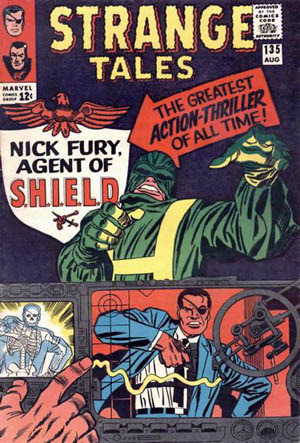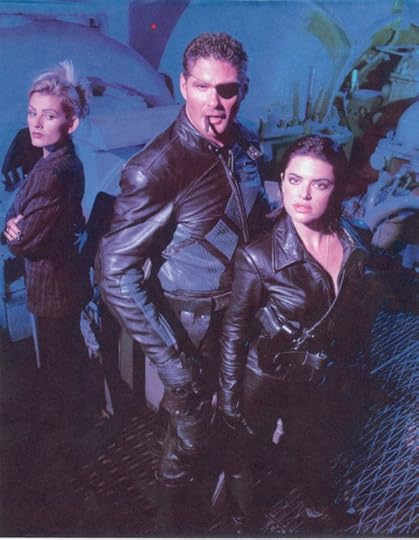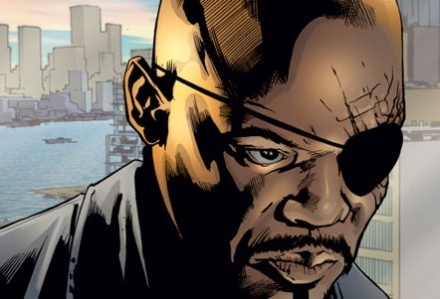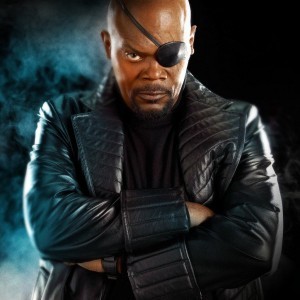Nick Fury: A retrospective

Nick Fury of S.H.I.E.L.D. (Strange Tales #167)
I’d like to tell you a story about a man named Nick Fury.
Fury is the creation of Stan Lee and Jack Kirby, the son of a World War I fighter pilot and a hero of World War II. First appearing as Sergeant Fury of The Howling Commandos back in 1963, Sgt. Fury fought alongside many iconic characters like Captain America, Bucky Barnes and Reed Richards, later known as Mister Fantastic of The Fantastic Four. In 1964, now a colonel, Fury appeared in Strange Tales issue #165 transformed from a CIA agent into a Cold War-era international man of mystery and adventure. Introducing S.H.I.E.L.D. and its nemesis HYDRA, this run solidified Fury’s place in the Marvel Universe, as did writer-penciller-colorist Jim Steranko’s legendary helm of the title. Edgy, different and always pushing the envelope on what a comic could be, this book made Nick Fury the recognizable character he is today: Fierce, uncompromising, and always one step ahead of the rest of the players on the board.
He’s gruff, he’s tough, he gets the job done. He’s not just a spy, he’s the spy. Various experiments with military science and the Infinity Formula have made him immortal, forever working in the shadows and backrooms of the Marvel Universe.

Strange Tales #135
Fury continued to make appearances in comics throughout the last few decades, such as Avengers and Fantastic Four, before starring in the miniseries Nick Fury vs. S.H.I.E.L.D. in 1988 and Nick Fury, Agent of S.H.I.E.L.D. from September 1989 – May 1993. In the 1990s he appeared in numerous miniseries and one-shots, and in the last decade has played major roles in various Marvel events from Secret War through Heroic Age. This year Fury’s “secret” African-American son Sgt. Marcus Johnson makes his appearance in the six-part mini Battle Scars, wherein he loses an eye and changes his name to Nick Fury, Jr.
Of course, by the time I was coming up in the comic world in the late 1990s and early 2000s, my impression of Nick Fury was drastically different from that of earlier readers and fans. First of all, during the 90s, Marvel hit a slump with most of its other heroes and titles. This period was fantastic for X-Men titles, however, with pretty great runs spanning nearly every branch of the mutant family tree. We had X-Cutioner’s Song, Age of Apocalypse, Onslaught, Operation: Zero Tolerance, and remember how awesome X-Force and Generation X were? I do. (I recently reread the Heroes Reborn: Iron Man trade for a bit of ’90s nostalgia. Spoilers: I probably shouldn’t have.) So a lot of people my age were a bit underwhelmed by things going on in the rest of the Marvel Universe, and my understanding of this character in particular was a bit limited. By then I just knew him as the cigar-chewing, take-no-shit, sarcastic old Nick Fury that cropped up from time to time to be crotchety and secretive, often to a campy degree.
Also, you know, we had this:

Nick Fury: Agent of S.H.I.E.L.D. Possibly the worst film ever made.
The hilariously lackluster Nick Fury: Agent of S.H.I.E.L.D. movie, starring David Hasselhoff and written by David S. Goyer, currently of Nolan-verse Batman street cred. Needless to say, my appreciation of Nick Fury in the 1990s was mixed with reverence for great stories of the past, with the cheesy B-movie fondness stuff like this rouses in me. Then in August 2001, Ultimate Nick Fury arrived on the scene in Ultimate Team-Up #5, and it got kind of interesting. Part of The Ultimates universe, this Nick Fury is an African-American General who ditched the Italian-American heritage and white-walls for a freshly shaven head and a demeanor and appearance strikingly akin to that of Samuel L. Jackson, after whom the character was modeled.

Ultimate Nick Fury.
This Fury, for me at least, was a little more intriguing. The brainchild of Brian Michael Bendis and Mike Allred, this Fury is a little more duplicitous, a little more two-faced. This guy, quite frankly, does some really shady stuff. It was fascinating, too, to see a historically white character be rebooted as a PoC. Still, I can’t say I’m a huge fan. He’s entertaining to read about, sure, but not my favorite. (At this point I was still reading a lot of X-Force and Deadpool, quite preoccupied by Warren Ellis‘ repeated attempts to kill Pete Wisdom and all that.) Fast-forward a few years later to Iron Man and Iron Man 2, and later Captain America: The First Avenger and The Avengers, when Samuel L. Jackson took up the mantle in the Marvel Cinematic Universe of the character that had been remade in his image. Then things got even more interesting.

Samuel L. Jackson as Nick Fury
The Fury we see in Iron Man 2 is telling Tony Stark about his father Howard and the riddle of his heart. While still keeping up his mysterious and imposing image, he fills in some of the gaps in Tony’s understanding about his emotionally-distant father, and pushes him forward into discovering and synthesizing the element that saves his life. In Captain America and subsequently The Avengers, Fury tries to persuade Steve Rogers to come back to the fight. He does this out of a need for soldiers on the field against Loki, but also a seeming concern for Steve’s well-being, still trying to adjust to the modern world. This Fury deeply values those under his command, like fan-favorite Agent Phil Coulson, but isn’t afraid to emotionally manipulate people to get what he wants, such as using Coulson’s death to light a fire under Stark’s and Roger’s respective butts. He has no qualms with lying to those around him and defying the orders of his superiors, either, using his sense of justice and morality to rationalize his decision to rally a bunch of dangerous and emotionally volatile super-types to fight Earth’s battles.
To me this Fury is a very subtle, complex and layered character, maybe more so than his previous iterations. He’s sympathetic, and empathetic, even in a world full of crazy aliens and gods and people in spangly jumpsuits trying to blow up Manhattan. He seems almost paternal toward Tony and Steve at times, but willing to use them, their strengths and their weaknesses to his own ends. That makes him dangerous because he seems like he really does care, and he can still use, cheat and manipulate people in spite of that. Beyond that, I find myself deeply fascinated by this guy. Where did he come from? How did he get to this position? How much harder was his road, due to racial and social obstacles? Does he truly care about these men and women he’s assembled, or will he turn on them if it suits the bigger picture?
Frankly, I don’t know, but I want to. That’s what interests me about this Nick Fury. The nice thing about all of these Nicks, however, is that we can all have favorites. With so many versions, each existing separately from the rest, fans can be their preferred canon and stick with it. Getting back into comics because of the MCU has given me a lot of respect for Nick Fury as a character and a fixture in Marvel mythology. I can appreciate the cigar-chewing old spy of the comic continuity, while still enjoying his MCU counterpart.
And isn’t that what nerding is all about?



